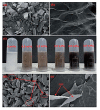Advances in Biodegradable 3D Printed Scaffolds with Carbon-Based Nanomaterials for Bone Regeneration
- PMID: 33187218
- PMCID: PMC7697295
- DOI: 10.3390/ma13225083
Advances in Biodegradable 3D Printed Scaffolds with Carbon-Based Nanomaterials for Bone Regeneration
Abstract
Bone possesses an inherent capacity to fix itself. However, when a defect larger than a critical size appears, external solutions must be applied. Traditionally, an autograft has been the most used solution in these situations. However, it presents some issues such as donor-site morbidity. In this context, porous biodegradable scaffolds have emerged as an interesting solution. They act as external support for cell growth and degrade when the defect is repaired. For an adequate performance, these scaffolds must meet specific requirements: biocompatibility, interconnected porosity, mechanical properties and biodegradability. To obtain the required porosity, many methods have conventionally been used (e.g., electrospinning, freeze-drying and salt-leaching). However, from the development of additive manufacturing methods a promising solution for this application has been proposed since such methods allow the complete customisation and control of scaffold geometry and porosity. Furthermore, carbon-based nanomaterials present the potential to impart osteoconductivity and antimicrobial properties and reinforce the matrix from a mechanical perspective. These properties make them ideal for use as nanomaterials to improve the properties and performance of scaffolds for bone tissue engineering. This work explores the potential research opportunities and challenges of 3D printed biodegradable composite-based scaffolds containing carbon-based nanomaterials for bone tissue engineering applications.
Keywords: additive manufacturing; biodegradable scaffolds; bone tissue engineering; carbon-based nanomaterials.
Conflict of interest statement
The authors declare no conflict of interest.
Figures














Similar articles
-
Three-Dimensional Printing of Biodegradable Piperazine-Based Polyurethane-Urea Scaffolds with Enhanced Osteogenesis for Bone Regeneration.ACS Appl Mater Interfaces. 2019 Mar 6;11(9):9415-9424. doi: 10.1021/acsami.8b20323. Epub 2019 Feb 13. ACS Appl Mater Interfaces. 2019. PMID: 30698946
-
Three-dimensional (3D) printed scaffold and material selection for bone repair.Acta Biomater. 2019 Jan 15;84:16-33. doi: 10.1016/j.actbio.2018.11.039. Epub 2018 Nov 24. Acta Biomater. 2019. PMID: 30481607 Review.
-
Additively manufactured biodegradable porous magnesium.Acta Biomater. 2018 Feb;67:378-392. doi: 10.1016/j.actbio.2017.12.008. Epub 2017 Dec 12. Acta Biomater. 2018. PMID: 29242158
-
Emerging bone tissue engineering via Polyhydroxyalkanoate (PHA)-based scaffolds.Mater Sci Eng C Mater Biol Appl. 2017 Oct 1;79:917-929. doi: 10.1016/j.msec.2017.05.132. Epub 2017 May 22. Mater Sci Eng C Mater Biol Appl. 2017. PMID: 28629097 Review.
-
Combinatory approach for developing silk fibroin scaffolds for cartilage regeneration.Acta Biomater. 2018 May;72:167-181. doi: 10.1016/j.actbio.2018.03.047. Epub 2018 Apr 5. Acta Biomater. 2018. PMID: 29626700
Cited by
-
Biphasic Calcium Phosphate and Activated Carbon Microparticles in a Plasma Clot for Bone Reconstruction and In Situ Drug Delivery: A Feasibility Study.Materials (Basel). 2024 Apr 11;17(8):1749. doi: 10.3390/ma17081749. Materials (Basel). 2024. PMID: 38673106 Free PMC article.
-
Extruded PLA Nanocomposites Modified by Graphene Oxide and Ionic Liquid.Polymers (Basel). 2021 Feb 22;13(4):655. doi: 10.3390/polym13040655. Polymers (Basel). 2021. PMID: 33671778 Free PMC article.
-
Additive manufacturing of sustainable biomaterials for biomedical applications.Asian J Pharm Sci. 2023 May;18(3):100812. doi: 10.1016/j.ajps.2023.100812. Epub 2023 Apr 27. Asian J Pharm Sci. 2023. PMID: 37274921 Free PMC article. Review.
-
The Investigation of Interlaminar Failures Caused by Production Parameters in Case of Additive Manufactured Polymers.Polymers (Basel). 2021 Feb 13;13(4):556. doi: 10.3390/polym13040556. Polymers (Basel). 2021. PMID: 33668572 Free PMC article.
-
The Mechanical, Thermal, and Chemical Properties of PLA-Mg Filaments Produced via a Colloidal Route for Fused-Filament Fabrication.Polymers (Basel). 2022 Dec 10;14(24):5414. doi: 10.3390/polym14245414. Polymers (Basel). 2022. PMID: 36559781 Free PMC article.
References
-
- Jones M.S., Waterson B. Principles of management of long bone fractures and fracture healing. Surgery. 2020;38:91–99. doi: 10.1016/j.mpsur.2019.12.010. - DOI
Publication types
LinkOut - more resources
Full Text Sources

